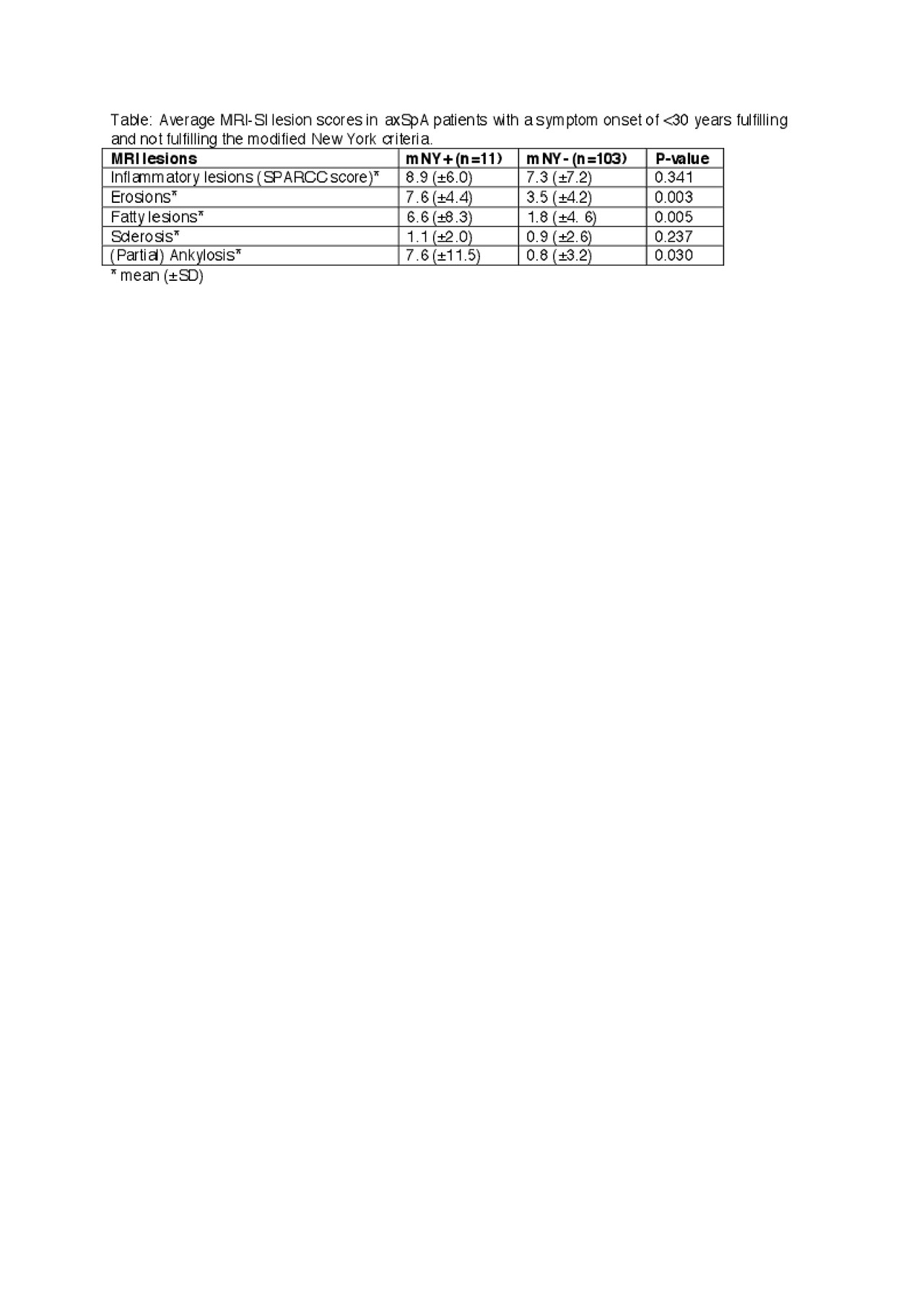Session Information
Session Type: ACR Abstract Session
Session Time: 2:30PM-4:00PM
Background/Purpose: The modified New York criteria (mNY) combine clinical symptoms with radiographic sacroiliitis on conventional pelvic radiographs (X-SI) classifying radiographic axial SpA patients (r-axSpA). AxSpA is known to typically start in the third era of life but there is a diagnostic delay of ±7 years. As the mNY criteria classify the most typical and severe expression of axSpA it is suggested that the mNY criteria are less useful in younger patients. Purpose of the study is to explore the diagnostic utility of the mNY criteria in newly diagnosed axSpA patients with a symptom onset < 30 years. In addition, describe the extent of lesions on MRI of the sacroiliac joints (MRI-SI) in mNY positive (mNY+) patients with a symptom onset < 30 years.
Methods: This study involved newly diagnosed axSpA patients, age ≥18 years, from a Belgian (Be-Giant) cohort. Patients underwent diagnostic tests involving clinical examination, lab tests, and imaging assessment containing an X-SI and an MRI-SI. mNY criteria was assessed on X-SI. MRI-SI reads contained the assessment of inflammatory lesions according to the Spondyloarthritis Research Consortium of Canada (SPARCC) scoring method and erosions, fatty lesions (FL), sclerosis, ankylosis using an adapted method of the SPARCC. Also, the ASAS definition of a positive MRI-SI was evaluated. T1-weighted and STIR images were viewed simultaneously. X-SI and MRI-SI were evaluated independently by 3 trained readers who were also blinded for clinical features. Imaging scores (X-SI grading according to the mNY criteria and mNY fulfillment, and MRI-SI lesion scores) were calculated as 2 out of 3 reader scores.
Results: In the 173 patients with available X-SI, the average age at symptom onset was 27.4 years old. In 114/173 (65.9%) patients, the symptom onset was below 30 years. Of those, 11 (9.6%) patients fulfilled the mNY criteria. Seven of the 11 (63.6%) patients that were mNY+ were male, which was slightly lower than in the mNY- patients (n=55; 53.4%). The presence of HLA-B27 was comparable between mNY+ and mNY- patients; 8 (72.7%) patients and 82 (79.6%) patients, respectively. Average X-SI grading in mNY+ patients was 4.7±1.3 (on a scale from 0-8) and in mNY negative (mNY-) patients (n=103) the average X-SI grading was 1.1±1.1.When looking at the MRI-SI assessment, 8/11 mNY+ patients (72.7%) and 60/103 mNY- patients (58.3%) had a positive MRI-SI (ASAS definition). The table shows the mean scores for MRI-SI lesions. In erosions, fatty lesions and ankylosis, either partial or complete ankylosis, there was a statistically significant difference (p< 0.05) between mNY+ and mNY- patients.
Conclusion: Patients with newly diagnosed axSpA and a symptom onset before 30 years infrequently fulfill the mNY criteria. A statistically significant difference in the presence of MRI-SI structural lesions was reported between mNY+ and mNY- patients. AxSpA patients with an early symptom onset have more erosions, fatty lesions and ankylosis on MRI when fulfilling the mNY criteria.
To cite this abstract in AMA style:
de Hooge M, De Craemer A, Renson T, Carron P, Deroo L, Elewaut D, Van den Bosch F. AxSpA Patients with Symptom Onset < 30 Years Have More Structural Lesions on MRI of the Sacroiliac Joints When Fulfilling the Modified New York Criteria [abstract]. Arthritis Rheumatol. 2019; 71 (suppl 10). https://acrabstracts.org/abstract/axspa-patients-with-symptom-onset-30-years-have-more-structural-lesions-on-mri-of-the-sacroiliac-joints-when-fulfilling-the-modified-new-york-criteria/. Accessed .« Back to 2019 ACR/ARP Annual Meeting
ACR Meeting Abstracts - https://acrabstracts.org/abstract/axspa-patients-with-symptom-onset-30-years-have-more-structural-lesions-on-mri-of-the-sacroiliac-joints-when-fulfilling-the-modified-new-york-criteria/

